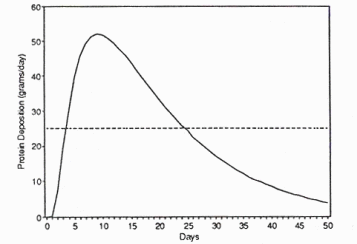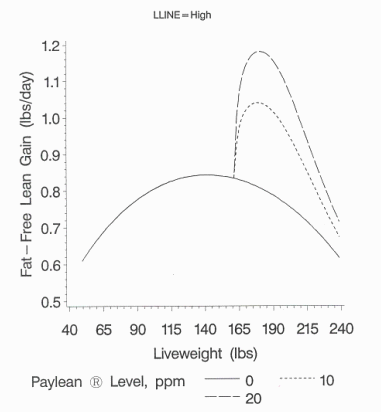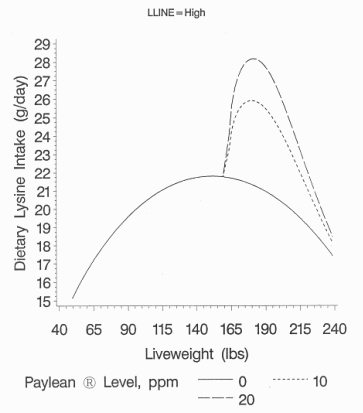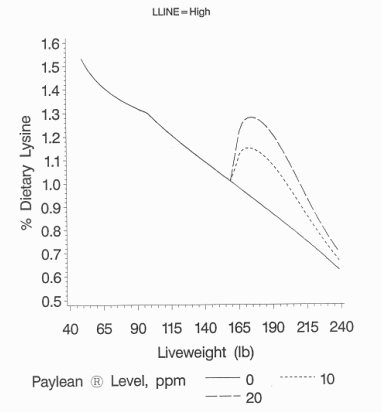
Purdue Pork Page Archive
A. P. Schinckel and B. T. Richert
Animal Sciences Department, Purdue University
1PAYLEAN - ractopamine hydrochloride by Elanco
Pork producers have the goal to efficiently produce lean, quality pork to compete with alternative animal products. The implementation of lean value carcass pricing systems has led to the selection of pigs with increased lean growth rates, increased carcass lean percentages and improved lean feed conversion. Health, nutrition, and facility management strategies have been implemented to increase commercially achievable lean growth rates.
Paylean is a feed additive that has the potential to further increase the rate and efficiency of muscle tissue growth. It is a feed additive containing ractopamine hydrochloride, a small molecule that increases muscle protein growth and improves feed efficiency. Ractopamine is a member of a class of compounds called phenethanolamines. Paylean is neither a hormone, steroid, antibiotic or a product of biotechnology. Paylean has been approved to be fed at levels of 4.5 to 18 grams per ton (5-20 ppm) from 150 to 240 lbs. live weight (last 90 lbs. of gain prior to slaughter). Paylean has undergone extensive evaluation and review by the Food and Drug Administration for its' effectiveness and safety. The majority of trials evaluated the use of ractopamine at the 18 gram/ton level for the last 90 lbs. of live weight gain before marketing. In these trials, ractopamine increased fat-free lean gain by 34% and empty body protein accretion by 24% (Table 1). Ractopamine increased growth rate while decreasing feed intake. Tenth rib fat depth (off-midline) was reduced by 13.7% and lean mass increased by 11%. Dressing percent increased from 73.3 to 74.4%, a 1.5 percentage increase.
The magnitude of the improvements in growth and carcass traits is affected by the level of Paylean fed (Table 2). Pigs fed 4.5 g/ton Paylean grew almost as fast as the pigs fed Paylean at the 9 and 18 g/ton levels. For lean percentage and backfat depth, approximately 40 to 50% of the 18 g/ton response could be achieved by the 4.5 g/ton level. Pigs fed at 9.0 g/ton level performed intermediate to pigs fed at 4.5 and 18 g/ton levels. The relative improvements in performance have been modeled as a function of the dietary level of Paylean.
Paylean increased daily fat-free lean gain by an average of 34% for pigs fed 20 ppm and 23.3% for pigs fed 10 ppm for the last 90 lb. of live weight gain before slaughter. These percentage increases in fat-free lean gain are consistent among slaughter weight ranges from 220 to 280 lbs. The percentage lean growth responses to Paylean are consistent across genotypes with different lean growth potentials. Two studies consisting of seven genotypes with substantially different lean growth rates fed 20 ppm Paylean resulted in a consistent 34% increase in lean gain regardless of genotype. Therefore, greater Paylean lean growth responses will occur in pigs of high lean growth genotypes. In other words, Paylean complements genotypes with high lean growth potentials by increasing their advantage over average genotypes by an additional 34%.
Paylean does not have the same effect on different carcass measurements. Paylean has the greatest impact on 10th rib backfat depth taken off-midline (Table 3). Off-midline fat depth taken from tenth to last rib are more accurate predictors of carcass composition than midline fat depth. Paylean has a much smaller impact to reduce midline fat depth but substantially increases loin eye area. Although the 4.5 g/ton level does not substantially reduce fat depth, the loin eye areas are increased at the 4.5 g/ton dosage.
Ractopamine research has shown that the lean growth response to ractopamine is not constant over the entire 90 lb. gain feeding period. The response increases, reaches a plateau, and then declines (Figure 1). The maximum response is achieved at 22-26 lbs. of live weight gain or approximately 19-24 days on Paylean (20 ppm) supplemented feed.
The daily fat-free lean growth rate for a high lean growth genotype fed 0, 10, or 20 ppm Paylean is shown in figure 2. When fed from 150-240 lb. live weight, Paylean increases daily fat-free lean growth rate at a time when lean growth is normally decreasing, especially for low-medium lean growth genotypes.
The increased fat-free lean growth rates provided by Paylean caused increases in essential amino-acid requirements. Both daily and percent dietary lysine requirements will increase with the use of Paylean (Figures 3 and 4). Based on projected requirements, producers may consider phase feeding two levels of lysine from 150-240 lbs. when feeding Paylean.
Feeding Paylean repartitions nutrients away from fat growth towards lean growth. Feed intakes vary among commercial production units, genetic populations, and seasons. Low energy intakes can limit the lean growth rate of pigs. Pigs fed Paylean can achieve 34% higher maximum daily fat-free lean growth rates with lower energy intakes than those needed for conventional pigs to achieve their lower lean growth rates (Figures 5 and 6). This allows Paylean-fed pigs to achieve high lean growth rates under commercial environments with reduced energy intakes that normally limit lean growth.
The economic returns of feeding Paylean has two components. Paylean improves growth rate, feed efficiency and dressing percentage (Table 4). This $3.64 per pig advantage can be realized by all pork producers. The additional advantage of feeding ractopamine is the increased value of the extra 10.45 lbs. of fat-free lean. This is approximately $9 to $11 for pork processors selling closely trimmed loins and utilizing the ham lean in value added products. One difficulty is predicting the percentage of this $9 to $11 advantage that will be received by pork producers. Ractopamine alters the distribution of lean and increases the percentage of total carcass lean in the hams. Commonly used carcass measurements, even when accurately collected under research conditions will predict only part of the actual increase in fat-free lean mass caused by feeding ractopamine (Table 5). Last-rib backfat is the least accurate measurement in predicting the lean mass of Paylean fed pigs. This is due to the fact that Paylean only reduces last-rib midline back fat thickness .03 inches. Optical probe loin depth and fat depth or standard ribbed carcass measurement will only predict about half of the Paylean response for increased lean percentage.
The actual fat-free lean advantage predicted by a pork processor is going to be affected by a number of factors including; (1) the accuracy of the data and measurements used in the development of the equation; (2) the inclusion of Paylean fed pigs in the data set used to develop the equations; (3) the technologies used to predict lean mass and accuracy of the measurements in the pork processing plant; and (4) the relative emphasis the equations place on measure of muscle mass including loin depth, loin eye area, and TOBEC values. This is especially true for pigs fed Paylean at the 5 and 10 g/ton levels. Also, it is not possible to simply "add a constant" to account for the Paylean advantage. The Paylean advantage is not a constant but is affected by the level of Paylean fed, the duration of feeding before market, lysine level in the diet, and genetic potential for lean growth. The optimal use of ractopamine and marketing strategy will be dependent on the ability of the carcass pricing system to reward the pork producer for the additional carcass lean produced by the feeding of ractopamine. As the payment for lean tissue versus fat tissue increases, the optimal use of Paylean, both level and duration of feeding increase. Feed costs, market prices and individual pork processor value systems all impact the optimal use of Paylean. Paylean has been demonstrated to have a very small impact on pork quality. Ractopamine, by increasing protein content of the muscle may increase ham processing yields. Sensory panels have found no difference between Paylean fed pigs and pigs fed control diets for juiciness, flavor, or tenderness. However, two trials have found Paylean fed pigs to have slightly higher Warner-Bratzler shear force values.
Summary
Pigs fed Paylean show large advantages in terms of lean growth, lean feed conversion, and carcass lean percentage. The optimal use of Paylean including level and duration of use will be dependent on carcass pricing system ability to detect and reward the pork producer for the extra pounds of lean. Paylean has been shown to have little impact on pork quality.
Table 1. Summary of ractopamine response*.
|
Response |
Percent Improvement |
|---|---|
|
Increased fat-free lean growth |
34.0% |
|
Increased protein accretion |
24.0% |
|
Decreased feed intake |
5.5% |
|
Increased ADG |
8.9% |
|
Improved F/G |
14.2% |
|
Reduced backfat thickness |
13.7% |
|
Increased carcass lean mass |
11.1% |
|
Increased dressing percent |
1.5% |
*18.5 g/ton (20 ppm) level for the last 90 lbs. of live weight gain.
Table 2. Impact of ractopamine level on pig growth and carcass measurement.
|
|
Ractopamine Level, g/ton |
|||
|---|---|---|---|---|
|
|
0 |
4.5 |
9.0 |
18.0 |
|
ADG, lb./d |
1.80 |
1.98 |
1.99 |
2.01 |
|
ADFI, lb./d |
3.06 |
3.06 |
2.97 |
2.98 |
|
Feed/Gain |
3.7 |
3.41 |
3.36 |
3.28 |
|
Dressing Percent |
72.1 |
72.5 |
72.7 |
73.0 |
|
10th Rib fat depth, in. |
.99 |
.94 |
.92 |
.87 |
|
LEA, in2 |
5.15 |
5.55 |
5.70 |
5.84 |
|
% Dissected lean |
52.8 |
55.5 |
-- |
58.2 |
|
% Dissected Fat |
27.1 |
25.2 |
-- |
23.0 |
Watkins et al., 1988, 6 trials, 888 pigs
Table 3. Effect of Paylean levels on carcass measurements.
|
Paylean Dosage, g/ton |
10th Rib Backfat Depth, in |
Midline Last Rib Backfat, in |
Average Midline Backfat, in |
10th Rib Loin Eye Area, in2 |
|---|---|---|---|---|
|
0 |
1.08 |
.99 |
1.21 |
5.08 |
|
4.5 |
1.06 |
1.00 |
1.23 |
5.51 |
|
9.0 |
.99 |
.98 |
1.19 |
5.68 |
|
18.0 |
.95 |
.97 |
1.17 |
5.80 |
Table 4. Value per pig of feeding 18 g/ton Ractopamine for the last 90 lbs. before market.
|
Growth 4.1 less days x .15 |
.62 |
|
Feed Cost: |
|
|
337 lbs. of .60% lysine $.0503/lb. |
16.95 |
|
289 lbs. of .78% lysine $.0539/lb |
15.58 |
|
48 lbs. less feed |
1.37 |
|
Dressing percentage 1.1% greater at 250 lbs. live weight |
|
|
2.75 lb at .60/lb carcass weight |
1.65 |
|
Total |
$3.64 |
Table 5. Percent of the ractopamine increse in fat-free lean mass predicted by various carcass measurements.
|
Carcass Measurement |
% of the Fat-free Lean Paylean Response detected* |
|---|---|
|
Midline last rib backfat lean and fat depth, carcass weight |
15.2 |
|
Optical probe |
52.4 |
|
Tenth rib fat depth, loin eye area, carcass weight |
49.5 |
|
TOBEC, carcass weight |
74.1 |
|
Dissected ham lean |
95.4 |
|
TOBEC, fat depth, carcass weight |
82.1 |
|
Best TOBEC and fat depth, carcass weight |
99.0 |
*The amount of the increase in fat-free lean mass as predicted from carefully collected measurements and prediction equations as a percentage of the actual increase in fat-free lean mass in pigs fed Ractopamine (18 g/ton for the last 90 lbs live weight gain).

Figure 1. Increase in maximum protein deposition due to ractopamine fed at 20 ppm.

Figure 2. Fat-free lean gain of pigs receiving Paylean.

Figure 3. Dietary lysine requirements for pigs receiving Paylean.

Figure 4. Dietary lysine concentration for pigs receiving Paylean.
Purdue Pork Page Archive